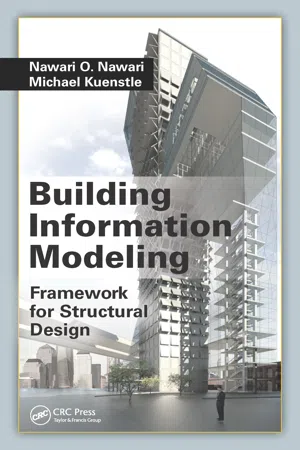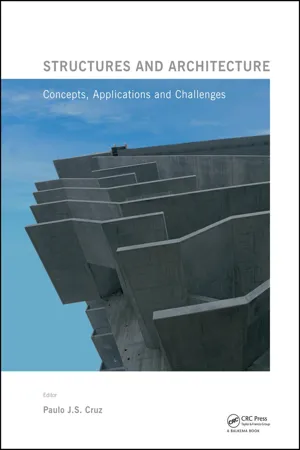Technology & Engineering
Structural Analysis
Structural analysis is a process used to predict and understand the behavior of structures under various conditions. It involves studying how forces and loads affect the stability, strength, and performance of a structure. By analyzing the internal and external forces acting on a structure, engineers can design and optimize buildings, bridges, and other infrastructure to ensure safety and efficiency.
Written by Perlego with AI-assistance
Related key terms
1 of 5
8 Key excerpts on "Structural Analysis"
- eBook - PDF
Building Information Modeling
Framework for Structural Design
- Nawari O. Nawari, Michael Kuenstle(Authors)
- 2015(Publication Date)
- CRC Press(Publisher)
161 6 Structural Analysis INTRODUCTION Structural Analysis within the structure and architecture synergy (SAS) framework establishes the notion that Structural Analysis computation is a primary tool not only to verify structural decisions but also to provide assistance for design strategies. The Structural Analysis is thus an integral part of the overall building design. Structural Analysis is conducted to verify that any structure must possess the following: Strength and stability : It must be stable and strong enough (i.e., provide nec-essary strength) to keep the building up under any type of load action so it does not collapse on either a local or a global scale (e.g., because of ten-sion, compression, bending, buckling, instability, yielding, fracture, etc.). The structure makes the building and spaces within the building possible; it also gives support to other building systems, such as mechanical, electrical and plumbing systems. Serviceability : It must be durable and stiff enough to control the functional performance, such as excessive deformation, vibrations, and drift. In building structures, applied loads flow along the members and joints to the external supports (i.e., foundations). Because the applied loads cause internal forces in the members and joints, one can visualize the supporting structural elements as substituted by equivalent, multifaceted three-dimensional (3D) force systems. In other words, under various external load actions, such as live load, wind, seismic forces, thermal stresses, vibration, or settlement, the structure responds by deform-ing and changing form, thereby causing strains in the members, which in turn cor-respond to internal forces denoted as stresses or stress results. - eBook - PDF
- Aslam Kassimali(Author)
- 2019(Publication Date)
- Cengage Learning EMEA(Publisher)
Part One Introduction to Structural Analysis and Loads Copyright 2020 Cengage Learning. All Rights Reserved. May not be copied, scanned, or duplicated, in whole or in part. Due to electronic rights, some third party content may be suppressed from the eBook and/or eChapter(s). Editorial review has deemed that any suppressed content does not materially affect the overall learning experience. Cengage Learning reserves the right to remove additional content at any time if subsequent rights restrictions require it. Copyright 2020 Cengage Learning. All Rights Reserved. May not be copied, scanned, or duplicated, in whole or in part. Due to electronic rights, some third party content may be suppressed from the eBook and/or eChapter(s). Editorial review has deemed that any suppressed content does not materially affect the overall learning experience. Cengage Learning reserves the right to remove additional content at any time if subsequent rights restrictions require it. 3 Marina City District, Chicago Hisham Ibrahim/Photographer’s Choice RF/Getty Images 1 Structural Analysis is the prediction of the performance of a given structure under prescribed loads and y or other external effects, such as support move-ments and temperature changes . The performance characteristics commonly of interest in the design of structures are (1) stresses or stress resultants, such as axial forces, shear forces, and bending moments; (2) deflections; and (3) support reactions. Thus, the analysis of a structure usually involves deter-mination of these quantities as caused by a given loading condition. The objec-tive of this text is to present the methods for the analysis of structures in static equilibrium. This chapter provides a general introduction to the subject of Structural Analysis. We first give a brief historical background, including names of people whose work is important in the field. Then we discuss the role of Structural Analysis in structural engineering projects. - eBook - PDF
- Zhuming Bi, Walter D. Pilkey, Deborah F. Pilkey(Authors)
- 2020(Publication Date)
- Wiley(Publisher)
518 FINITE ELEMENT ANALYSIS (FEA) FOR STRESS ANALYSIS is formulated, the basics of FEA theory is reviewed, the general procedure of using FEA for Structural Analysis is presented, and a number of case studies are presented to illustrate how FEA is applied for stress analysis. 6.1 Structural Analysis PROBLEMS Structural Analysis is to determine the effects of loads on solid objects. Structural Analysis is required for any structures or objects that withstand different loads, such as machines, tools, vehi- cles, buildings, bridges, and instruments. Structural Analysis aims to compute stress distribution and the deformation of solids, as well as other associated quantities, such as safety factors, reac- tion forces, displacements, and stability. Structural Analysis is used to verify if an object meets the given functional requirements (FRs), such as the strengths, accuracy, and cost. Therefore, Structural Analysis is essential to the majority of engineering designs. As shown in Fig. 6.1, since structural design is essential to the design of any product, structural design problems are highly diversified in terms of time-dependence of loads, materials properties Structural Analysis Problems Time Dependence of Loads Static Analysis Fatigue Analysis Materials Properties Homogeneous Heterogeneous Solid Domains Single structure Assembled Structure Modal Analysis Couplings Solid Mechanics Multi -Phase Problems Multi -physics Figure 6.1 Classification of Structural Analysis problems (Bi 2018). TYPES OF ENGINEERING ANALYSIS METHODS 519 of solids, the characteristics of solid domains, and coupling of disciplinary behaviors. The method of SCFs introduced in the precedent chapters is suitable only to the manual calculations for the simplest design cases at every aspect. - eBook - PDF
- Tianjian Ji, Adrian J. Bell, Brian R. Ellis(Authors)
- 2015(Publication Date)
- CRC Press(Publisher)
Structural behaviour describes, mathematically or descriptively, how structures behave under loading. Qualitative analysis, or approximate analysis, is often conducted to help understand the behaviour of a structure, for example the likely deformed shapes and distribution of internal forces, and is a useful stage of the conceptual design process. Structural behaviour and structural concepts emphasise different aspects of structural engineering, but they are interrelated. Structural behaviour and structural concepts are discussed further in Chapter 13. 1 Overview of Structural Concepts 5 1.2 WHY STUDY STRUCTURAL CONCEPTS? Structural concepts provide a basis for study, analysis and design in civil and structural engineering, and therefore their use is ideal for educating civil and structural engineering students. There are many reasons to emphasise the importance of the understanding and use of structural concepts in education and in practice. 1. In the past, our understanding of structural concepts was developed through working with hand calculations, many of which have now been replaced by computer-based calculations. Indeed, understanding structural concepts is fundamental to the sound and innovative design of structures and is of increasing importance due to the wide use of computers and the, often unquestioning, reliance placed on the results of computer analyses. Computed results will be flawed if they are based on incorrect assumptions and modelling, and engineers must under-stand this fact. 2. Analysis of the structural response to loads is much less demanding today than it was 20 or more years ago. Structural behaviour can be easily and quickly analysed using a personal computer (PC) and finite element (FE) software. It is the input loads and the model of a struc-ture that are critical, as the output from a computer cannot be any better than the input. A good understanding of structural concepts will help to avoid errors when creating computer input. - eBook - PDF
Multi-Span Large Bridges
International Conference on Multi-Span Large Bridges, 1-3 July 2015, Porto, Portugal
- Pedro Pacheco, Filipe Magalhaes, Pedro Pacheco, Filipe Magalhaes(Authors)
- 2015(Publication Date)
- CRC Press(Publisher)
2 ANALYSIS 2.1 Structural mechanics Structural mechanics is the computation of deformations, deflections, and internal forces or stresses within structures, either for design or for performance evaluation of existing structures. Structural mechanics analysis needs input data such as structural loads, the structure’s geometric representa-tion and support conditions, and the materials’ properties. Output quantities may include support reactions, stresses and displacements. Advanced structural mechanics may include the effects of stability and non-linear behaviors. Mechanics of structures is a field of study within applied mechanics that investigates the behavior of structures under mechanical loads, such as bending of a beam, buckling of a column, torsion of a shaft, deflection of a thin shell, and vibration of a bridge. There are three approaches to the analysis: the energy methods, flexibility method or direct stiffness method which later developed into the finite element method. As one of the methods of Structural Analysis, the direct stiffness method, also known as the matrix stiffness method, is particularly suited for computer-automated analysis of complex structures including the statically indeterminate type. It is a matrix method that makes use of the members stiffness relations for computing member forces and displacements in structures. The direct stiffness method is the most common implementation of the finite element method (FEM). In applying the method, the system must be modeled as a set of simpler, idealized elements interconnected at the nodes. The material stiffness properties of these elements are then, through matrix mathematics, compiled into a sin-gle matrix equation which governs the behavior of the entire idealized structure. - eBook - PDF
- William M.C. McKenzie(Author)
- 2013(Publication Date)
- CRC Press(Publisher)
1. Structural Analysis and Design 1.1 Introduction The design of structures, of which analysis is an integral part, is frequently undertaken using computer software. This can only be done safely and effectively if those undertaking the design fully understand the concepts, principles and assumptions on which the computer software is based. It is vitally important therefore that design engineers develop this knowledge and understanding by studying and using hand -methods of analysis based on the same concepts and principles, e.g. equilibrium, energy theorems, elastic, elasto -plastic and plastic behaviour and mathematical modelling. In addition to providing a mechanism for developing knowledge and understanding, hand -methods also provide a useful tool for readily obtaining approximate solutions during preliminary design and an independent check on the answers obtained from computer analyses. The methods explained and illustrated in this text, whilst not exhaustive, include those most widely used in typical design offices, e.g. method -of -sections/joint resolution/unit load/McCaulay’s method/moment distribution/plastic analysis etc. In Chapter 7 a résumé is given of the direct stiffness method; the technique used in developing most computer software analysis packages. The examples and problems in this case have been restricted and used to illustrate the processes undertaken when using matrix analysis; this is not regarded as a hand -method of analysis. 1.2 Equilibrium All structural analyses are based on satisfying one of the fundamental laws of physics, i.e. F = ma Equation (1) where F is the force system acting on a body m is the mass of the body a is the acceleration of the body Structural analyses carried out on the basis of a force system inducing a dynamic response, for example structural vibration induced by wind loading, earthquake loading, moving machinery, vehicular traffic etc., have a non-zero value for ‘ a ’ the acceleration. - George Somerville(Author)
- 2008(Publication Date)
- CRC Press(Publisher)
196 Management of deteriorating concrete structures Most commonly in design, element strength is controlled by the rein-forcement. In assessment also, this will be the case. Hence, the key features at the investigative stage will be to determine the amount, location and type of reinforcement. This is particularly important for older structures, where the reinforcement characteristics may well be different from those in cur-rent practice. The objective will be to establish a representative stress–strain curve, to be used in the modified design models. This latter action is most relevant to the corrosion situation, in checking not only on strength but also on ductility. 6.5 Analysis of structures The fundamental purpose of Structural Analysis is to determine the dis-tribution of internal forces and moments, due to imposed loads whose magnitude and distribution are laid down in Codes or Standards with the intention of generating maximum design values for these internal action effects. Analysis may also be used to evaluate stresses, strains and displacements. A brief overall perspective of analytical methods is given in Section 5.3.3, with a bias towards assessment. At the detailed assessment stage (Figure 5.1), it is necessary to look at analysis in a little more detail, since the strategy in this book is to model and modify design approaches, and the modelling of the geometry and proportions of the structure becomes more acute. In current design Codes [6.2], recommended approaches are: (i) linear elastic behaviour; (ii) linear elastic behaviour, with limited re-distribution based on specific assumptions, and some restrictions, e.g. not for column design; (iii) plastic behaviour; (iv) non-linear behaviour. (i) and (ii) are by far the most common for most structures, particularly for frames and sub-frames in buildings, but with yield-line analysis (iii) making something of a come back for slabs.- eBook - PDF
Structures and Architecture
New concepts, applications and challenges
- Paulo J. Cruz(Author)
- 2013(Publication Date)
- CRC Press(Publisher)
As a modern engineering science, Structural Analysis addresses the concept of force in its rela- tional and operational form, representing it with the aid of vectors and force diagrams, i.e., mathematical and geometric constructs. The equivalence of force and vector added to Vilanova Artigas’s intellectual background the notion that force is subject to abstraction, quantification, mechanization and to be transformed into a graphical phenomenon – which forms the base of the science of statics. Duhem (1991:11) starts telling the history of statics by the development of mechanics made by Aristotle and Archimedes, passing through Leonardo da Vinci, Galileo Galilei and Simon Stevin, among others, until its whole systematization in seventeenth century. Statics, as we know it today, is the result of an intellectual process that culminated with the un- derstanding that the physical world is, in its essence, mathematical and mechanical in its mode of functioning. As translated by Drake (1957:238-9), Galileo contended that the language of the universe is mathematical – the most abstract of all sciences: “Philosophy is written in this grand book, the universe, which stands continually open to our gaze. But the book cannot be under- stood unless one first learns to comprehend the language and read the letters in which it is com- posed. It is written in the language of mathematics, and its characters are triangles, circles and 1840 other geometrical figures, without which it is humanly impossible to understand a single word of it.” Geometry was adopted by the science of statics as a means to represent the physical world through the concept of lines of force, i.e., vectors. Hall et al (1999:3) define force as “that which changes, or tends to change, the velocity of a body. Force is a vector quantity, possessing direc- tion as well as magnitude.
Index pages curate the most relevant extracts from our library of academic textbooks. They’ve been created using an in-house natural language model (NLM), each adding context and meaning to key research topics.







